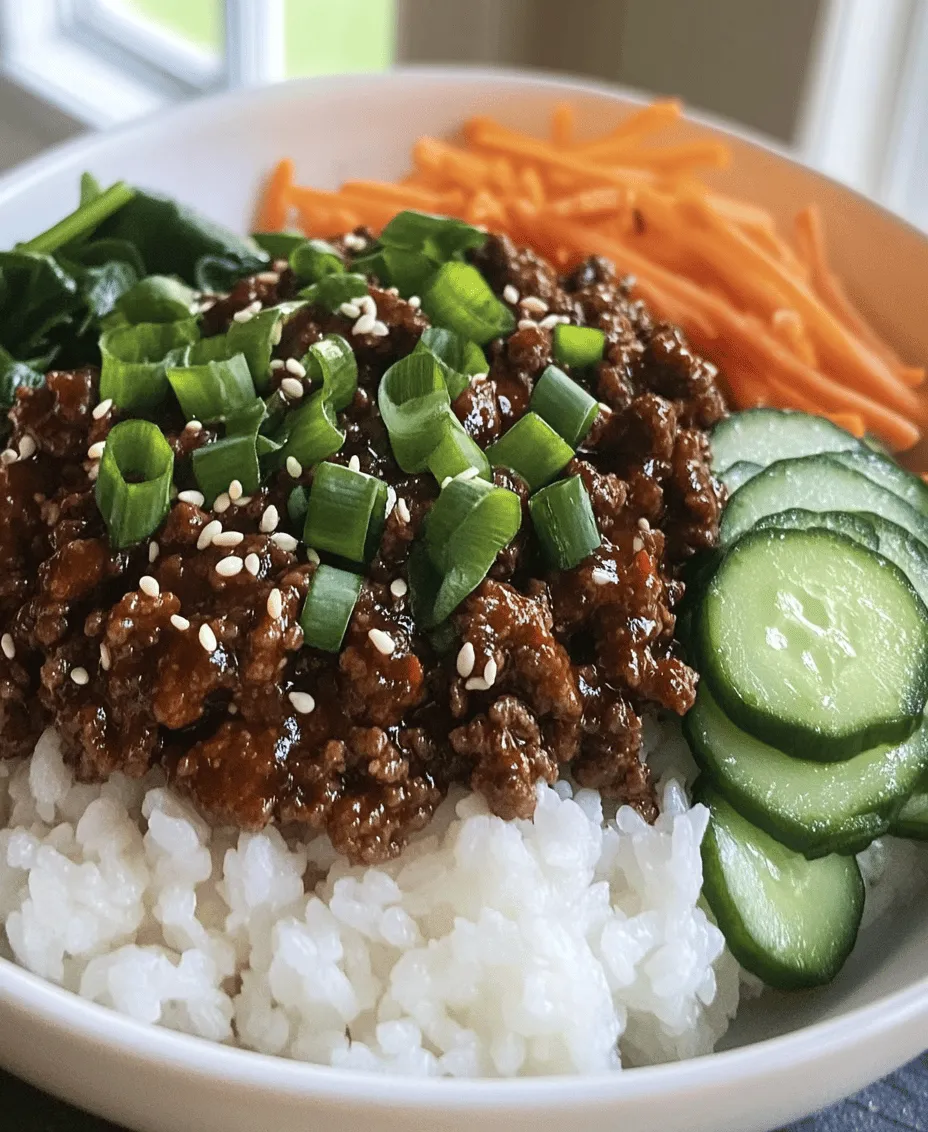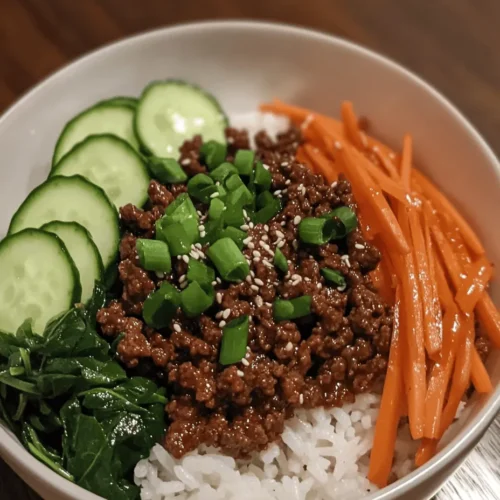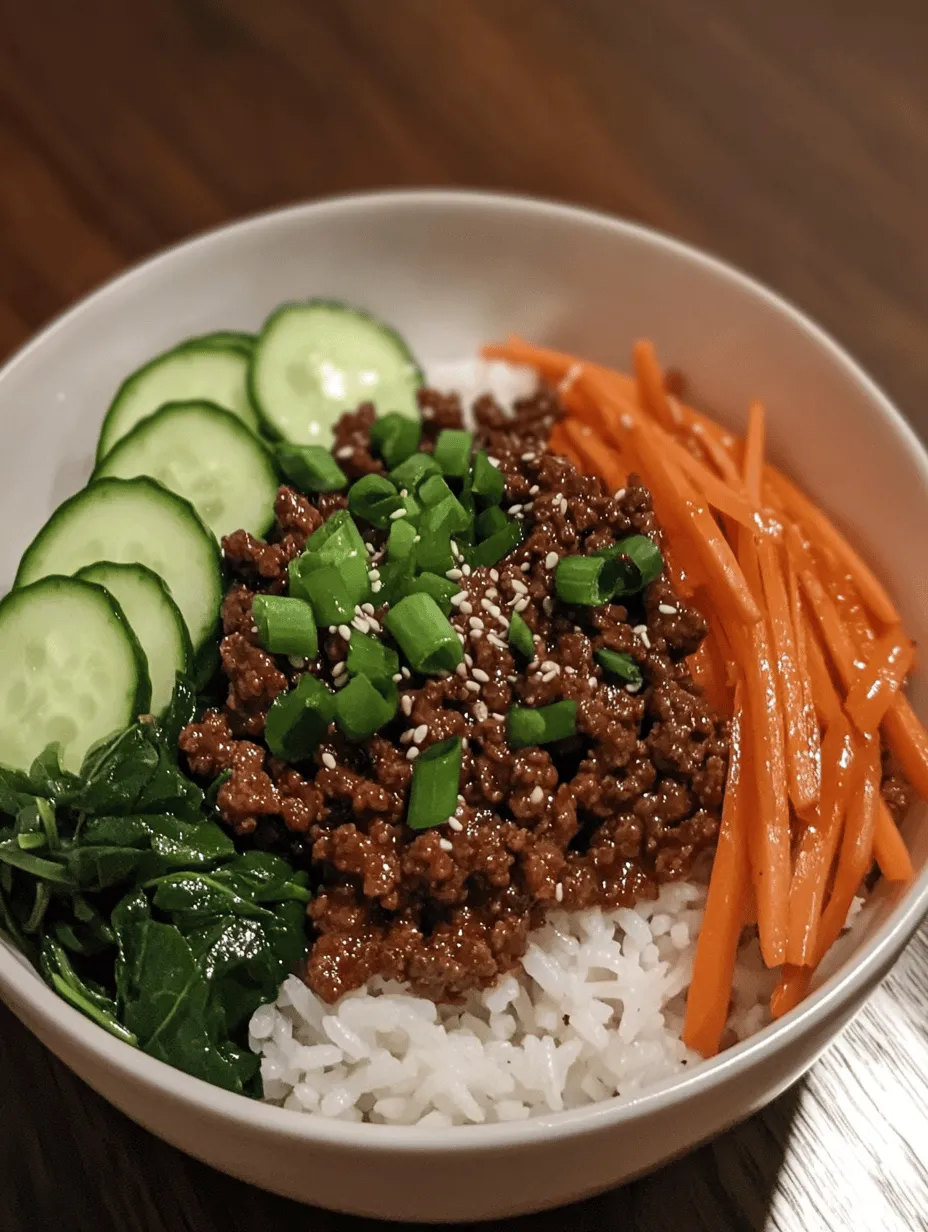Introduction
Korean cuisine is renowned for its vibrant flavors and comforting dishes that celebrate the harmony of taste and texture. One standout dish that captures this essence is the Korean Ground Beef Bowl. This delightful meal is a perfect embodiment of how simple ingredients can come together to create something truly delicious. The Korean Ground Beef Bowl is not only quick and easy to make, but it also showcases a balance of savory, sweet, and spicy flavors that will leave your taste buds dancing.
Incorporating diverse flavors into everyday meals is essential for keeping our diets exciting and nourishing. The Korean Ground Beef Bowl makes it easy to introduce a variety of tastes and textures into your weekly meal rotation. Whether you’re a busy parent looking for a quick weeknight dinner or a culinary enthusiast eager to explore new recipes, this dish offers something for everyone. Its growing popularity reflects a broader trend in the culinary world, where the fusion of flavors and traditions is celebrated.
This dish holds cultural significance in Korean cuisine, often served as a comforting meal that brings families together. With its roots deeply embedded in Korean food culture, the Ground Beef Bowl has been embraced by home cooks and restaurant chefs alike, making it a staple in both traditional and modern culinary settings.
Understanding the Ingredients
Ground Beef
At the heart of the Korean Ground Beef Bowl is ground beef, which is not only a hearty protein choice but also a versatile ingredient that absorbs flavors well. From a nutritional standpoint, ground beef is rich in protein, iron, and B vitamins, making it a substantial addition to any meal. The flavor profile of ground beef is robust, offering a savory base that pairs beautifully with the bold seasonings typical of Korean cooking.
Soy Sauce
Soy sauce is a cornerstone of Korean cuisine, serving as a key ingredient in marinades, stir-fries, and sauces. In this recipe, it plays a crucial role in adding depth and umami to the dish. The rich, salty flavor of soy sauce enhances the overall taste of the ground beef while also helping to tenderize the meat. When selecting soy sauce, consider opting for a low-sodium version to maintain a healthier balance without sacrificing flavor.
Brown Sugar
Brown sugar may seem like an unusual addition to a savory dish, but it is essential for balancing flavors. In the Korean Ground Beef Bowl, brown sugar helps to counteract the saltiness of the soy sauce and adds a subtle sweetness that rounds out the dish. This balance is crucial in achieving the complex flavor profile that Korean cuisine is known for.
Sesame Oil
A small drizzle of sesame oil is what gives the Korean Ground Beef Bowl its aromatic touch. This oil, derived from toasted sesame seeds, has a rich, nutty flavor that is characteristic of Asian cooking. Just a teaspoon can elevate the dish, imparting a distinctive aroma that enhances the overall eating experience.
Garlic and Ginger
No Korean dish would be complete without garlic and ginger, two essential aromatics that form the backbone of many recipes. Garlic adds a pungent, savory note, while ginger introduces a warm, spicy undertone. Together, they create a fragrant base that complements the ground beef beautifully. The use of fresh garlic and ginger is recommended to maximize their flavors, but powdered versions can work in a pinch.
Gochujang
One of the standout ingredients in this recipe is gochujang, a staple Korean chili paste made from fermented soybeans, glutinous rice, and red chili powder. This unique condiment adds a spicy kick and a touch of sweetness, making it a versatile ingredient in various Korean dishes. When incorporating gochujang into your marinade, you can easily adjust the spice levels to suit your taste preferences, ensuring that everyone can enjoy this flavorful meal.
Rice Vinegar
Rice vinegar is another important addition to the marinade, offering a tangy flavor that helps to brighten the dish. Its acidity balances the richness of the beef and the sweetness of the brown sugar, creating a harmonious blend of flavors. Rice vinegar is milder than regular vinegar, making it a perfect choice for this recipe.
Vegetables
Fresh vegetables play a vital role in the Korean Ground Beef Bowl, not only for their nutritional benefits but also for the textures and colors they bring to the dish. Common vegetable additions include green onions, carrots, and baby spinach. Green onions add a fresh, crisp flavor, while carrots provide a slight sweetness and crunch. Baby spinach offers a nutritional boost and a vibrant green hue. By using seasonal and fresh produce, you can enhance the healthfulness and flavor of your dish.
Jasmine Rice
When it comes to serving the Korean Ground Beef Bowl, jasmine rice is the preferred choice. Known for its fragrant aroma and fluffy texture, jasmine rice complements the savory beef and vegetables perfectly. The slightly sticky quality of jasmine rice allows it to hold onto the flavors of the dish, making each bite a delightful experience. While you can substitute other rice varieties, jasmine rice brings an authentic touch that truly elevates the meal.
Garnishes
Finally, garnishes like sesame seeds and thinly sliced cucumbers not only enhance the presentation but also add extra flavor and texture to the dish. Sesame seeds provide a nutty crunch, while cucumbers offer a refreshing contrast to the rich ground beef. Together, these garnishes create a visually appealing and delicious final touch to your Korean Ground Beef Bowl.
Preparing the Marinade
Creating the marinade is a crucial step that sets the stage for the dish’s flavor. Follow these simple steps to prepare a marinade that will infuse your ground beef with a delicious depth of taste:
1. Gather Your Ingredients: Start by measuring out the soy sauce, brown sugar, sesame oil, minced garlic, grated ginger, and gochujang. Having everything ready will streamline the process.
2. Mix the Marinade: In a medium-sized bowl, combine ¼ cup of soy sauce, 1 tablespoon of brown sugar, 1 tablespoon of sesame oil, 2-3 cloves of minced garlic, 1 tablespoon of grated ginger, and 1 tablespoon of gochujang. Whisk these ingredients together until the brown sugar has dissolved and the mixture is smooth.
3. Taste and Adjust: It’s essential to taste the marinade and adjust it to your liking. If you prefer a spicier kick, feel free to add more gochujang. Conversely, if you’re looking for a milder version, reduce the amount of chili paste.
4. Marinate the Beef: Place your ground beef in a large bowl or a resealable plastic bag. Pour the marinade over the beef, ensuring that it is evenly coated. For the best results, allow the beef to marinate for at least 30 minutes. This resting time allows the flavors to meld, resulting in a more flavorful dish.
5. Refrigerate: If you have time, refrigerate the marinated beef for a few hours or overnight. This extended marinating time will deepen the flavors, making the dish even more delicious.
Cooking the Ground Beef
Once the beef has marinated, it’s time to cook it to perfection. Properly browning the ground beef is crucial for achieving that rich, caramelized flavor. Follow these steps to ensure your beef is cooked just right:
1. Heat the Pan: Begin by heating a large skillet or wok over medium-high heat. Allow the pan to get hot before adding any ingredients, as this will help sear the beef and lock in its juices.
2. Add the Ground Beef: Once the pan is hot, add the marinated ground beef. Use a wooden spoon or spatula to break it up into smaller pieces as it cooks. This will help ensure even cooking and browning.
3. Brown the Beef: Allow the beef to cook undisturbed for a few minutes to achieve a nice browning on the bottom. Then, stir occasionally to prevent sticking and promote even browning. The goal is to cook the beef until it is no longer pink and has developed a rich color.
4. Drain Excess Fat: Depending on the fat content of your ground beef, you may find that there’s excess grease in the pan. To create a healthier dish, consider draining off some of the fat once the beef is fully cooked. This step is optional, but it can help lighten the dish and prevent it from being overly greasy.
5. Add Vegetables: Once the beef is browned and excess fat is drained, it’s time to incorporate your fresh vegetables. Add sliced carrots and baby spinach, stirring them into the beef mixture. Cook for an additional 2-3 minutes, or until the vegetables are tender but still vibrant.
With the beef and vegetables cooked to perfection, you will soon be ready to assemble your Korean Ground Beef Bowl, layering the flavorful ingredients over a bed of fluffy jasmine rice. The combination of savory beef, fresh vegetables, and aromatic garnishes will create a dish that not only satisfies the palate but also nourishes the body. Stay tuned for the next part, where we will discuss assembling the bowl and final presentation tips to elevate your dining experience.

How the Marinade Transforms the Beef During Cooking
The marinade is a crucial component of the Korean Ground Beef Bowl, as it not only infuses the meat with flavor but also plays a significant role in the cooking process. The combination of soy sauce, garlic, ginger, and sesame oil penetrates the beef, breaking down its fibers and resulting in a tender, juicy texture. This transformation occurs as the marinade’s acids and enzymes interact with the beef during cooking.
When the beef is cooked, it caramelizes slightly due to the sugars in the marinade, adding depth and a hint of sweetness to the overall flavor profile. This process enhances the savory notes of the dish, creating a delicious balance that complements the vibrant vegetables you’ll be adding later.
Incorporating Vegetables
Adding vegetables to your Korean Ground Beef Bowl not only enhances the dish’s nutritional value but also contributes to its visual appeal and flavor complexity. Vegetables such as bell peppers, carrots, and snap peas provide essential vitamins, minerals, and fiber, making this meal more balanced and satisfying.
Nutritional Advantages of Adding Vegetables
Incorporating vegetables into your bowl brings a wealth of health benefits. For instance, bell peppers are rich in vitamin C and antioxidants, while carrots are a great source of beta-carotene, which is essential for eye health. Snap peas add a delightful crunch and are a good source of dietary fiber, promoting digestive health. By including a variety of vegetables, you create a more wholesome meal that supports overall well-being.
Tips for Cooking the Vegetables to Maintain Texture and Color
To ensure that your vegetables retain their vibrant color and crisp texture, consider these tips:
1. Cook Quickly: Sauté your vegetables over high heat for a short period. This method helps to seal in their moisture while keeping them crisp.
2. Add Towards the End: For vegetables that require less cooking time, such as bell peppers and snap peas, add them to the pan after the beef is nearly cooked. This way, they will maintain their texture and color without becoming mushy.
3. Blanching Technique: For harder vegetables like carrots, blanch them in boiling water for a minute before adding them to the skillet. This technique softens them slightly while preserving their bright color.
By following these tips, you will ensure a delightful crunch in every bite of your Korean Ground Beef Bowl.
The Balance of Flavors Between the Beef and the Vegetables
The marriage of flavors among the beef and vegetables is essential to the dish’s success. The savory, slightly sweet beef pairs beautifully with the fresh, crisp vegetables, creating a harmonious balance. The umami richness of the beef enhances the natural sweetness of the vegetables, while the earthy notes of the soy sauce marinade add depth. This interplay of flavors makes each bite of the bowl satisfying and exciting.
Assembling the Bowls
With your beef and vegetables ready, it’s time to assemble the bowls. Presentation is key in making your Korean Ground Beef Bowl not only delicious but also visually appealing.
Visual Appeal of the Dish: Layering and Presentation Tips
When assembling your bowl, consider the following presentation tips:
1. Layer Thoughtfully: Start with a base of fluffy jasmine rice, which serves as the foundation of your bowl. Top it with a generous portion of the marinated ground beef, followed by a colorful assortment of the sautéed vegetables.
2. Use Color: Aim for a vibrant mix of colors for a visually enticing presentation. The rich brown of the beef, the bright green of snap peas, and the orange of carrots create an eye-catching contrast.
3. Add Textures: To enhance the dish further, consider adding crunchy elements like toasted sesame seeds or crushed peanuts on top. This not only elevates the flavor but also adds an enjoyable texture to every bite.
Importance of Portioning Jasmine Rice
Jasmine rice is a staple in many Asian dishes and is particularly suitable for this Korean Ground Beef Bowl. When portioning, a serving of about one cup of cooked jasmine rice per bowl is ideal. This amount allows for a balanced ratio of rice to beef and vegetables, ensuring that the flavors are well distributed without one element overpowering the others.
Suggestions on How to Serve the Bowls for Family-Style Dining
For a family-style dining experience, consider serving the components separately. Place the rice in a large bowl, the beef in another, and the vegetables in a third dish. This way, each person can customize their bowl to their liking, allowing for a more interactive and enjoyable meal. Provide small bowls for everyone to create their own perfect balance of flavors, accommodating personal preferences and dietary restrictions.
Garnishing and Serving Suggestions
The finishing touches on your Korean Ground Beef Bowl can elevate the dish from ordinary to extraordinary. While sesame seeds and sliced cucumbers are classic garnishes, there are many other options to explore.
Exploring Different Garnishing Options Beyond Sesame Seeds and Cucumbers
– Green Onions: Chopped green onions add a fresh, mild flavor and a pop of color.
– Pickled Vegetables: Korean pickled radish or kimchi can provide a tangy contrast to the savory beef.
– Fresh Herbs: Cilantro or Thai basil can add an aromatic touch and brighten the dish.
Pairing Suggestions: What to Serve Alongside the Korean Ground Beef Bowl
To complement your Korean Ground Beef Bowl, consider serving it with:
– Korean Side Dishes (Banchan): Traditional dishes like sautéed spinach (sigeumchi namul) or seasoned bean sprouts (kongnamul) can enrich the meal.
– A Simple Salad: A cucumber and carrot salad dressed with rice vinegar and sesame oil can provide a refreshing contrast.
– Soup: A light miso soup or a spicy Korean kimchi stew (kimchi jjigae) can round out the meal beautifully.
Cultural Context of Serving Bowls in Korean Dining
In Korean culture, meals are often served family-style, with communal dishes shared amongst diners. This practice fosters a sense of togetherness and encourages conversation during meals. By presenting your Korean Ground Beef Bowl in this manner, you embrace the cultural essence of sharing food and creating lasting memories with family and friends.
Nutritional Information
Understanding the nutritional content of your Korean Ground Beef Bowl allows you to enjoy it guilt-free. Here’s a breakdown of the estimated nutritional values per serving (based on a serving of beef, vegetables, and one cup of jasmine rice):
– Calories: Approximately 500-600 calories
– Protein: 30-35 grams
– Fats: 15-20 grams
– Carbohydrates: 60-70 grams
Health Benefits of the Ingredients Used in the Recipe
Each ingredient in the Korean Ground Beef Bowl contributes to its overall health benefits:
– Ground Beef: A great source of high-quality protein, iron, and B vitamins.
– Jasmine Rice: Provides quick energy due to its carbohydrate content, along with some fiber if you choose brown jasmine rice.
– Vegetables: Packed with vitamins, minerals, and fiber, making your meal not just filling but also nutritious.
Variations and Adaptations
The beauty of the Korean Ground Beef Bowl lies in its versatility. Here are some ideas for variations and adaptations:
Options for Substituting Ground Beef with Other Proteins
– Ground Chicken or Turkey: For a leaner option, ground chicken or turkey can be substituted without sacrificing flavor.
– Tofu or Tempeh: For a vegetarian or vegan option, crumbled tofu or tempeh can be marinated in the same sauce and sautéed until golden.
Vegetarian and Vegan Adaptations of the Recipe
To create a completely plant-based version, use plant-based ground meat or mushrooms for a hearty texture. Enhance the flavor by incorporating additional spices or sauces, such as sriracha or gochujang, to maintain that signature Korean essence.
Exploring Different Vegetable Combinations for Seasonal Variations
Feel free to experiment with seasonal vegetables. For example, zucchini, broccoli, or even roasted sweet potatoes can add unique flavors and textures. Adjust the cooking time based on the vegetables you choose to use.
Conclusion
The Korean Ground Beef Bowl is a delightful dish that encapsulates the essence of Korean cuisine while being approachable and satisfying. With its rich flavors, vibrant colors, and nutritional balance, it’s a meal that can easily become a family favorite.
We encourage you to experiment with the recipe, adjusting ingredients and flavors to suit your personal taste. Whether you stick to the classic version or make it your own, this bowl is sure to bring joy to your dining table. Embrace the enjoyment of cooking and the beauty of sharing meals with loved ones, as these moments are what truly make life flavorful.



